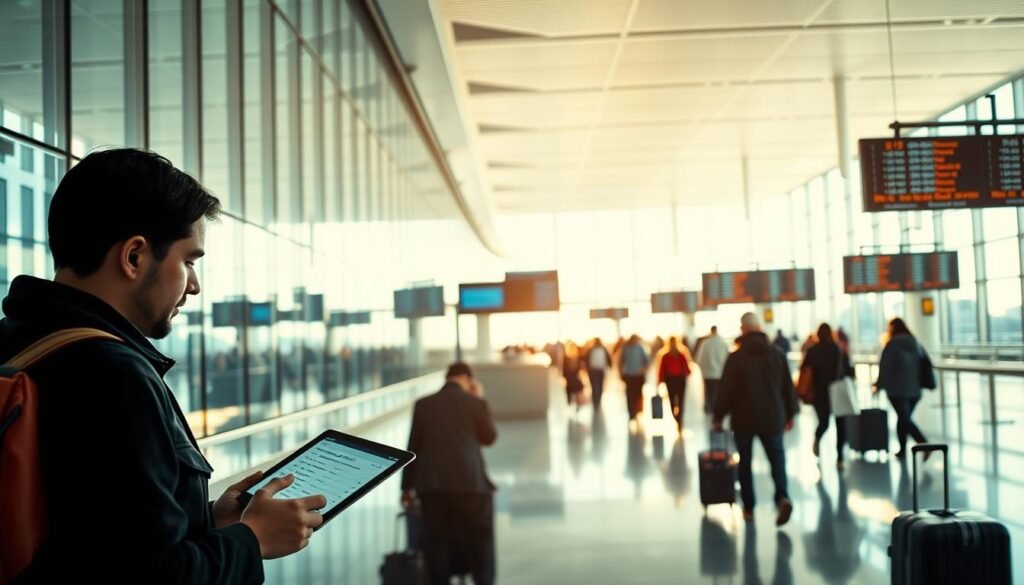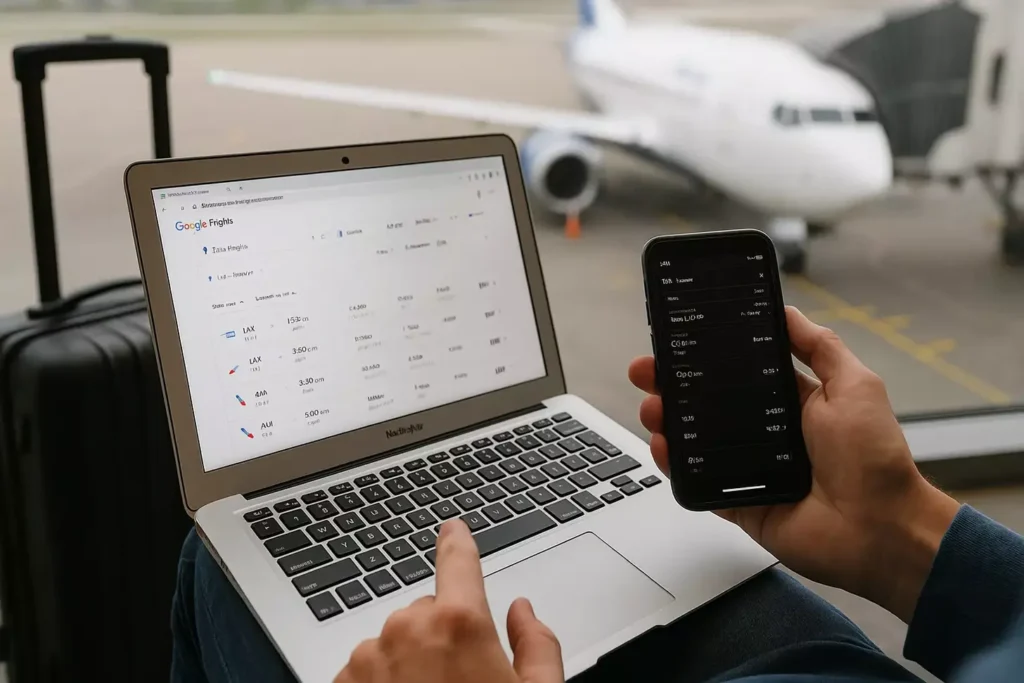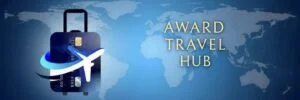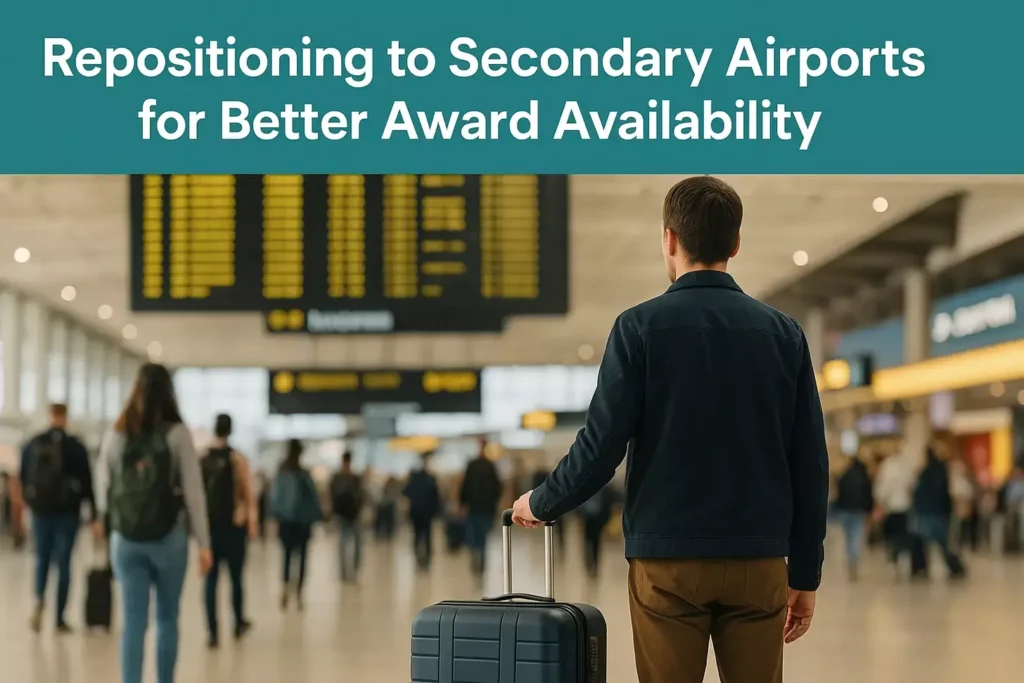Affiliate Disclosure: Award Travel Hub may earn a commission or referral bonus from some links on this site. These affiliate links help support our work and may influence the placement or promotion of certain products or services. However, our content is independently crafted to reflect honest opinions. Not all offers or products are included. There is no additional cost to users when they utilize our affiliate links.
Imagine planning your dream trip, only to find no premium seats available from your local hub. This is a common frustration for many travelers. But what if the solution was a short, inexpensive hop to a different city first?
We recently saw a traveler book a premium economy ticket from Los Angeles to India for under $1,000. This deal earned a massive amount of loyalty points. The key? They started their journey with a separate, low-cost flight from Atlanta to Los Angeles.
This clever tactic is known as a positioning flight. It involves booking a short initial leg to reach a major airport with superior options. This strategy unlocks incredible award availability and cash deals that simply don’t exist from your home airport.
Limiting your search to the nearest terminal means missing out. Some of the best airline deals require departing from specific hubs. By mastering this approach, you can access premium cabins and stretch your points much further.
We will guide you through everything you need to know about this powerful method. Learn how to find these opportunities, manage the risks, and start traveling smarter.
Key Takeaways
- A short, initial flight can unlock significantly better travel deals and award seat availability.
- This strategy is beneficial for accessing premium cabins that are sold out at your local airport.
- Major hub airports often offer more flight options and better loyalty-program sweet spots.
- Strategic planning can lead to substantial savings on both paid fares and award bookings.
- While it adds a step to your journey, the potential rewards—miles, points, and experiences — are often well worth it.
- This guide provides expert tips to help you navigate the process with confidence and success.
Understanding Positioning Flights and Their Benefits
What if a simple extra step could transform your travel options and unlock premium cabin experiences? This approach centers around strategic airport selection.
What is a Positioning Flight?
A positioning flight is a separate ticket that transports you to a different airport where your main journey begins. Unlike standard connections on one reservation, this involves two distinct bookings.
Consider this real example: Flying business class from Houston to Tokyo costs 117,500 American Airlines miles. The exact route from Los Angeles costs only 60,000 miles. That’s a savings of 57,500 miles!

To access this deal, you could book a positioning flight from Houston to Los Angeles for around $79. The substantial mileage savings make this strategy incredibly valuable.
Key Advantages for Award Availability and Cost Savings
Positioning flights offer multiple benefits that can dramatically improve your travel experience:
| Benefit | Impact | Example |
|---|---|---|
| Cost Savings | Access better fares from major hubs | Save hundreds on international flights |
| Award Availability | More premium cabin options | Find business class seats when the home airport shows none |
| Route Access | Reach destinations not served locally | Fly direct to Asia from West Coast hubs |
“The smartest travelers know that flexibility in departure points opens up a world of possibilities.”
Major hub airports typically offer more daily departures and better award space. This strategy also lets you access airline-specific sweet spots that may only be available from certain gateway cities.
How to Book a Positioning Flight for Optimal Savings
Mastering the art of positioning flights begins with a systematic booking approach. We guide you through each step to ensure maximum value from your travel strategy.
Step-by-Step Guide to Booking a Positioning Flight
Start by choosing your final destination. Flexibility with dates and cities creates more savings opportunities.
Search for your main flight first. Use tools like Google Flights to compare options from different departure airports. Look for the best cash fares or award availability.
Next, find your positioning flight from home to the optimal hub. Compare multiple airlines and departure times for the best combination.
Build sufficient buffer time between flights. Experts recommend at least 4-6 hours. Many travelers prefer overnight stays to minimize the risk of connections.
Book each flight separately. Complete your main booking first, then secure your positioning tickets.
| Tool | Primary Use | Best For |
|---|---|---|
| Google Flights | Cash fare comparisons | Finding the cheapest routing options |
| PointsYeah | Award search across programs | Comprehensive availability checking |
| Seats.aero | Real-time award alerts | Premium cabin availability |

Recommended Tools and Resources for Award Searches
Specialized tools make finding award seats more efficient. PointsYeah searches multiple loyalty programs simultaneously.
Seats.aero provides instant alerts when premium cabins become available. The Google Flights Points Path extension shows award pricing alongside cash fares.
Always compare redemption values before booking. Consider whether to use miles or pay cash for your positioning flight.
Repositioning to Secondary Airports for Better Award Availability
Have you ever discovered an incredible flight deal, only to realize it’s not available from your nearest city? This common scenario highlights a crucial truth. Airlines concentrate their best inventory, especially for premium cabins, at their major hub airports.
Gateways such as Los Angeles, New York, and Chicago offer the most flight options. This naturally leads to greater award availability and more attractive pricing. For travelers outside these hubs, a strategic positioning flight is the key to accessing these superior deals.
Why Major Hubs Deliver Superior Value
International carriers prioritize their primary U.S. gateways. They deploy newer aircraft and release more premium award seats from these cities. A positioning flight effectively moves you into this zone of opportunity.
This strategy is not just about cost. It can be the only way to book multiple tickets together or reach a specific destination not served by your home airport.
Real-World Success Stories
These examples show the power of this approach in action.
| Scenario | Solution | Outcome |
|---|---|---|
| Family from Houston to Barcelona | Positioning flight to Washington D.C. (IAD) | Accessed Air France business class for 50,000 miles per adult |
| Traveler seeking Qatar Qsuite | Searching all U.S. gateways, not just the closest airport | Found vastly different availability by departure city |
| Business class to Tokyo | Short, cheap flight to Los Angeles | Saved 57,500 miles compared to direct from Houston |
As you can see, flexibility with your starting point unlocks a better award landscape. It turns seemingly impossible itineraries into achievable dream trips.
Managing Risks and Challenges with Positioning Flights
Before committing to a positioning strategy, it’s crucial to assess the potential challenges and develop mitigation plans. The primary risk is separate tickets—if your initial flight is delayed, the airline for your main journey has no obligation to assist.
Strategies to Handle Delays, Cancellations, and Baggage Issues
We recommend significant buffer time between flights. While some suggest 3-6 hours, experienced travelers often allow 12-24 hours or even arrive the day before.
Baggage complications are another concern. Separate tickets mean collecting and rechecking luggage at your connection point. This adds time and increases the risk of lost items.
Planning Enough Buffer Time and Assessing Itinerary Complexity
Traveling with carry-on luggage only eliminates baggage transfer worries. This simplifies your journey and reduces stress.
Consider these risk management strategies:
- Book flights on credit cards with trip delay coverage
- Avoid the last flight of the day to your hub airport
- Research backup options in advance
- Monitor weather conditions before departure
Sometimes the added complexity isn’t worth the savings. This is especially true for time-sensitive trips or when traveling with family and multiple checked bags.
Enhancing Rewards and Credit Card Benefits While Traveling
Your choice of payment method can dramatically enhance the safety and value of your positioning strategy. We recommend using the right credit card for both your initial and first flight.
This approach provides crucial insurance and helps you earn valuable points.
Tips on Leveraging Credit Cards and Earning Rewards
Booking with a card that offers robust travel protection is essential. Look for benefits like trip delay reimbursement.
For example, the Chase Sapphire Preferred® card covers hotel and meal costs if a delay exceeds six hours. This protects your money and itinerary.
You also face a key decision: pay cash or use miles for the short hop? Using a small number of points can be a smart move.
One traveler booked an American Airlines positioning flight for just 8,000 miles and $6 in fees. This tiny investment unlocked a massive award saving on their international trip.
| Card Benefit | Application | Value |
|---|---|---|
| Trip Delay Insurance | Covers hotels/meals during long delays | Protects against unexpected costs |
| Lounge Access | Comfort during extended layovers | Improves the travel experience |
| Bonus Points on Travel | Earn extra miles on airline purchases | Reduces the net cost of your strategy |
Premium credit cards often include access to airport lounges. This turns a long wait into a comfortable break.
Note: Cards we feature are from partners. Terms apply to offers. Our opinions are always independent.
Conclusion
Unlocking luxury travel doesn’t always require starting from your nearest airport terminal. We’ve shown how strategic positioning flights can dramatically improve your award availability and savings.
This approach opens access to premium cabins and better flight deals. While separate tickets add complexity, careful planning minimizes risks.
Build generous buffer time between connections. Consider traveling with a carry-on only. Use credit cards with travel protection.
For flexible travelers, this strategy transforms dream trips into affordable realities. Start expanding your airport searches beyond your home city today.
Mastering positioning techniques empowers you to travel smarter. You’ll stretch your points and miles further than ever before.



